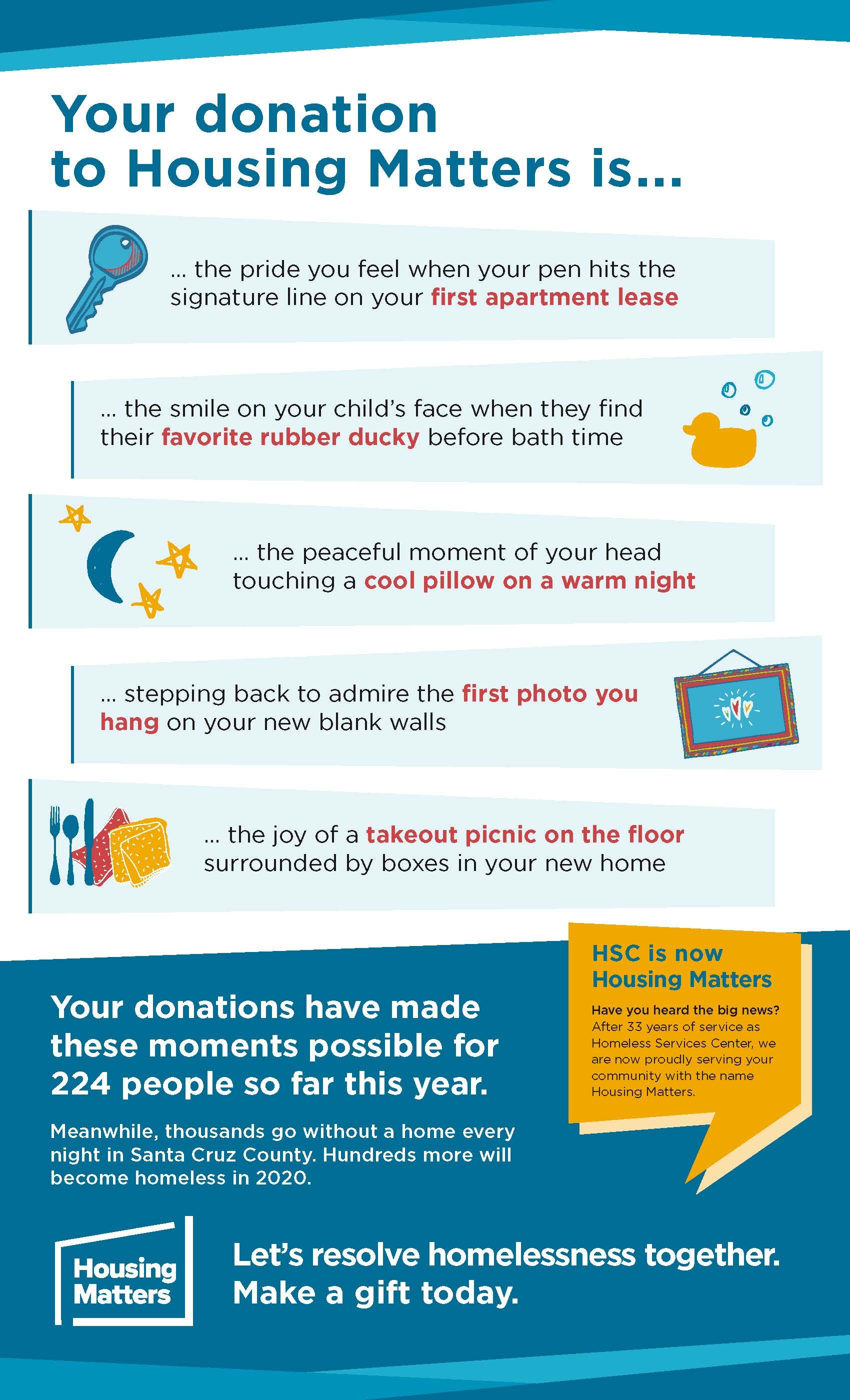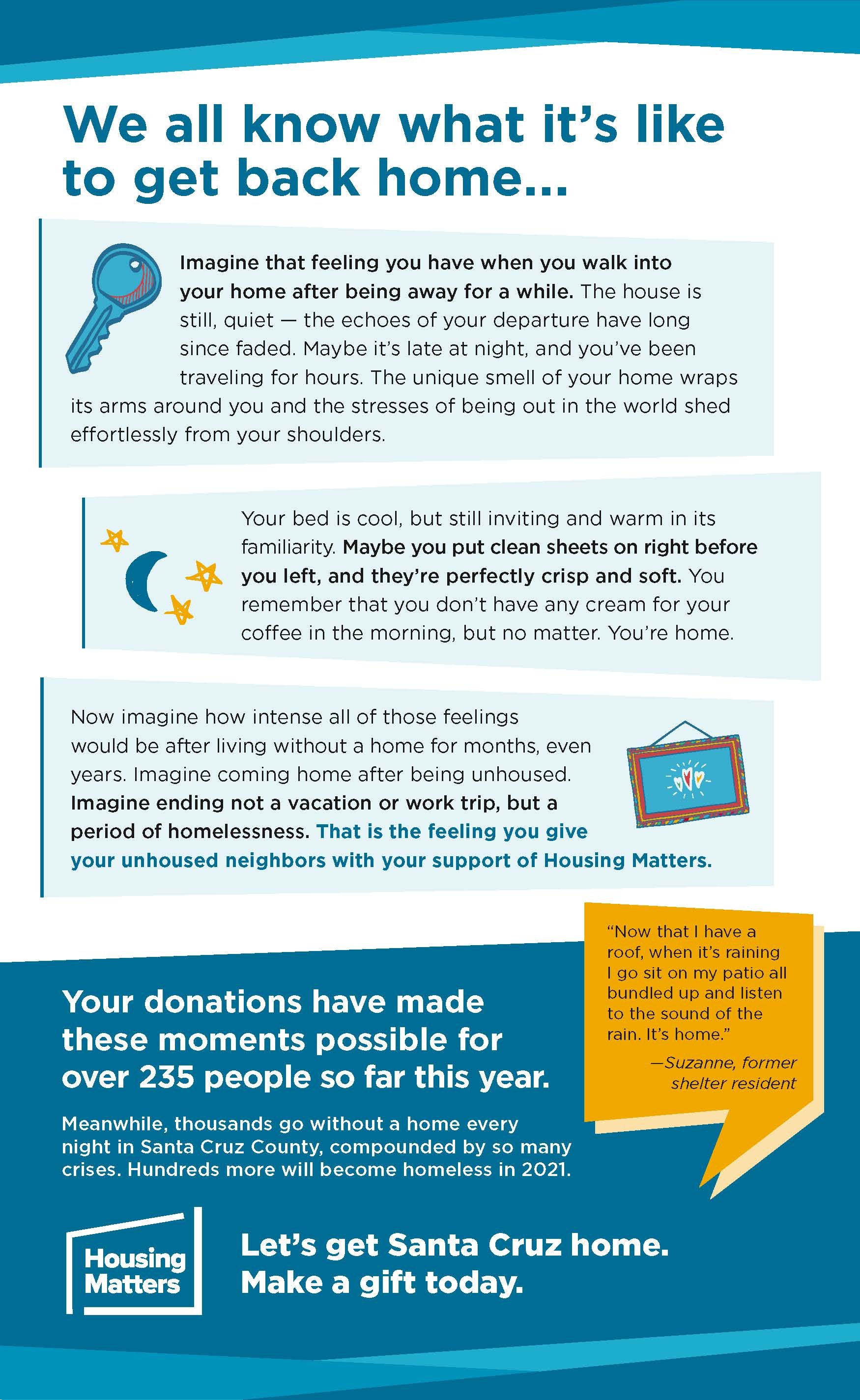Case Study
Housing Matters Development and Community Engagement
Thoughtful, solutions-oriented communications to drive a bold mission forward.
Before I started building the communications program at Housing Matters—the largest nonprofit working on homelessness in Santa Cruz County—I was leading the facilitation of renaming the organization. Once the new name and brand were in place, we got to work bringing year-round communications to a new level.
In an effort to combat the stigma that is so pervasive in this social issue, while modeling productive discussion of the issue, I emphatically directed the content into positive messages, and extended our communications plan to reach beyond the existing donor base.
In addition, realizing that donors need consistent stewardship in order to keep retention rates high, we focused on donor-centric content writing, impact-driven stats and infographics, and humanizing narratives about the nonprofit's clients, delivering meaningful content all year.
Housing Matters has wisely invested in building engagement in the local community, making the organization stand out among regional nonprofits. Going beyond the traditional nonprofit communications materials, I led the organization through building a suite of collateral and strategies that inspired, engaged, and drove action.
The process and some key components included the following:
In addition to the standard donor stewardship materials—an annual report and newsletters—we created additional touchpoints throughout the year
We revamped the organization’s major event—Soupline—to include a younger demographic, paving the way for the next wave of donors; our branding and promotional strategy was so successful, we were on track to sell out just a few weeks into event promotion
After Soupline had to be canceled due to COVID, we immediately pivoted to fundraising for a COVID Emergency Response Fund, raising $450,000 on a $250,000 goal with a simple and targeted email series
We built a community engagement program that consistently garnered participation from a wide variety of community members, many of whom converted into donors
Thanks to year-round stewardship, our donor retention rate grew steadily year over year
Our year-end fundraising campaign set new records each year
We published a survey to hear community opinions on homelessness, hoping for the industry standard response rate of 1-3%; we had a 12% response rate among all recipient groups
We created a variety of usable educational materials for community members to more effectively engage with the issue
The materials you see below include pre and during COVID contexts. Our strategies had to shift dramatically when the pandemic hit. Luckily, we had invested in building strong donor relationships up until that point, so we simply had to pivot our communications, but didn't lose any momentum.
The executive director saw the value of uplifting, proactive communications, and brought me in to build the communications department from the ground up. The investment paid off.
The work I did creating a strong communications program had a few goals:
Support fundraising
Grow base of supporters of Housing Matters so the community is more likely to say "yes" to local solutions to homelessness
Position Housing Matters as the regional leader in solutions to homelessness
We successfully hit all our goals, and our KPIs throughout the years continued to reach higher and higher. Some of our results included:
Grew fundraising significantly YoY (at least 20% each year)
Doubled our email contact lists in 18 months
Increased the number of media inquiries and consistently increased participation in our community engagement program
Most recently, Housing Matters was able to get community support to build a large new permanent supportive housing facility, the first of its kind in the area
Unless otherwise noted, I wrote and art directed all collateral shown below. Pieces written by others were edited by me.
Our fundraising materials included collateral that specifically reported on giving or made asks for donations.
These efforts were bolstered by year-round stewardship and community engagement activities.
Our community engagement materials were equal parts donor stewardship and community education, and included direct mail, advertisements, events and promotion, social media, eblasts, lead magnets, press, and more.
The more a community understands and cares about your work, the greater chance they’ll donate. This all comes down to having a strong changemaking theory (not sure what that means? Let’s talk!)
Building a strong communications and community engagement program was an iterative process, and we made progress from day one.
First step was to audit all existing materials, and determine what purpose each piece of collateral was serving. I then built a communications plan with all the key components: target audiences, goals, strategies, objectives, and tactics. We determined KPIs and outlined roles.
All of this took place while bringing current staff and board members along; it was critical to have buy-in in order to make this happen.
Finally, I incorporated my changemaking theory in order to ensure our communications plan was solid. (Psst: curious about my changemaking theory and how it could benefit your organization? Reach out and let's chat!)
(Shoutout to Bryan West, who did much of the design for the collateral shown below.)































